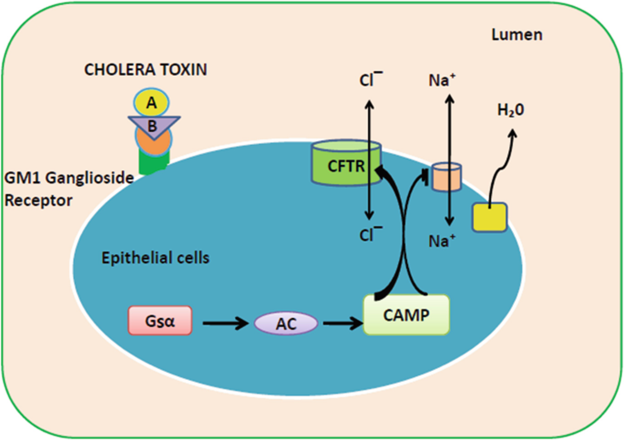General characteristics:
- Vibrio cholerae is a Gram-negative bacterium.
- It is a comma shaped, motile bacteria with monotrichous polar flagella.
- It is facultative anaerobe and prefers brackish water.
Classification:
- V. cholerae is classified on the basis of its somatic antigens (O-antigens) into serovars or serogroup, and there are atleast 155 known serogroups
- Serogroup O1 has two major serotypes, ogawa and Inaba, and the Hikojima serotype has been reported rarely. Based on certain biochemical characteristics and bacteriophage susceptibility, these serotypes can be further divided into two biotypes, classical and El Tor.
| Test | Classical | EL Tor |
| Hemolysis | -ve | +ve |
| VP Test | -ve | +ve |
| Polymyxin sensitivity | Sensitive | Resistant |
| Group IV phage susceptibility | Susceptible | Non-susceptible |
| Chicken Erythrocyte agglutination | -ve | +ve |
Mode of transmission:
Infection is acquired by feco-oral route and by ingestion of improperly cooked shellfish. The incubation period ranges from few hours to 2-3 days.
Virulence factors:
Vibrio cholerae employs an arsenal of virulence factors that contribute to its pathogenecity. These factors include:
Cholera toxin (CT)
It is also known as cholera enterotoxin. It is a heat labile toxin (protein) of mol. Wt. 85,600 KDa. It is structurally and functionally similar to heat labile enterotoxin of E. coli. However, CT is far more potent in biological activity. Cholera Toxin comprises of six protein subunits: five identical B subunits linked to one A subunit, generally denoted as AB5.
The active A subunit has a mol. wt. of 27,215 KDa and exhibits a biological activity. This A subunit further consists of two fragments: A1 and A2 connected together by covalent disulfide bond. The B subunit also known as binding factors are 5 in number each of molecular weight 11,677 KDa.
The cholera toxin inhibits the absorption capacity and activates the excretory chloride transport in intestinal enterocytes, eventually leading to loss of NaCl in intestinal lumen. In order to balance osmotic concentration large amount of water is secreted causing diarrhea.
Toxin co-regulated pilus (TCP)
It helps in adherance of V. cholerae to the mucosa of small intestine. TCP produced by epidemic strain of V. cholerae is a type IV pilus encoded on pathogenecity island and it is critical for virulence.V. cholerae O1 Eltor and V. cholerae O139 produce a second type IV pilus, the mannose sensitive hemagglutinin (MSHA). MSHA are rarely produced by classical strain. Role of MSHA in human virulence is somewhat unclear however antibiotics against MSHA are protective against infection with other strains
Motility
A single polar flagellar motility allows bacteria to swim through the lumen of the small intestine in search of nutrient rich cells and places for adherance to epithelial cells of small intestine, especially the crypts. Thus motility could also be an important factor for bacteria to break through the mucosal layer.
Accessory colonization factor
This also helps in adhesion of bacteria to intestinal mucosa.
Hemagglutinin protease (Mucinase)
It induces intestinal inflammation and also helps in releasing free vibrios from the bound mucosa to the intestinal lumen.
Neuraminidase
The enzyme destroys neuraminic acid thereby increasing toxin receptors for V. cholerae.
Siderophores
- It is responsible for sequestration of iron. In addition to above factors, several other factors like
- Accessory Cholera Enterotoxin(ACE), Zona Occludens Toxin (ZOT), Heat stable enterotoxin (ST), Cholix Toxin (Chx), Multifunctional Autoprocessing Repeats-in-Toxin (MARTX), Vibrio cholerae cytolysin (VCC), Mannose sensitive hemagglutinin (MSHA), etc. work in collaboration to infect and cause symptoms in the host.
- H. Capsule may or mayn’t be present
- Example: Non-O1 V. cholerae produces acidic polysaccharidescapsule. In contrast, V. cholerae O1 do not produce capsules
Pathogenesis of V. cholerae:
- Once the organism escapes gastric environment and reach small intestine, they cross the protective layer of mucus and reach the epithelial cells mediated by chemotactic motility, mucinase and proteolytic enzymes.
- TCP facilitates adhesion and colonization on the surface of epithelial cells.
- Then the organism produces cholera toxin, primarily responsible for the key features of cholera.
- The B subunit of cholera toxin binds to GM1 ganglioside receptors on the surface of jejunal epithelial cells, allowing the A subunit to enter the cell which then activates adenyl cyclase enzyme system.
- Adenyl cyclase activity results in an increased accumulation of intracellular cAMP. This causes mucosal membrane pumps to push the Cl- and HCO3- ions into the lumen of small intestine creating an isotonic gradient between the host cell and the lumen.
- To maintain the isotonicity, there is secretion of water and electrolytes into the lumen of gastrointestinal tract resulting purging diarrhea of “rice water stool”, a characteristics of cholera. This excessive fluid loss causes severe dehydration and hypotension and is fatal if left untreated.
- Throughout the course of infection vibrios remain attached to the epithelial cells but do not damage or invade them. Hence, blood and inflammatory cells are notably absent in stool.

Fig: Pathogenesis of Vibrio cholerae
Clinical manifestations of V. cholerae:
- Profuse watery diarrhea (commonly called rice-water diarrhea) with mucus flakes
- Vomiting
- Dehydration
- Decreased skin elasticity
- Sunken eyes
- Low grade fever rarely
- Hypovolemia, low Blood Pressure
- Muscle cramps (Hypokalemia, Hyponatremia, Hypoglycemia)
